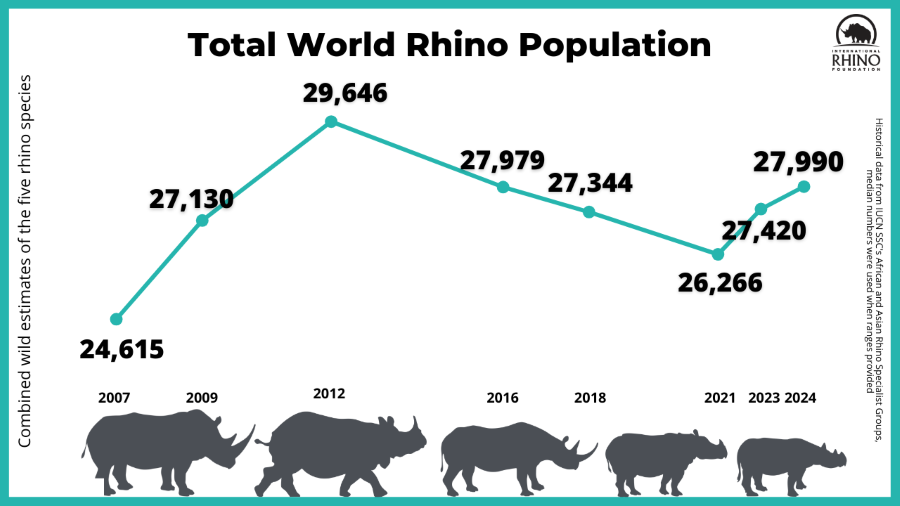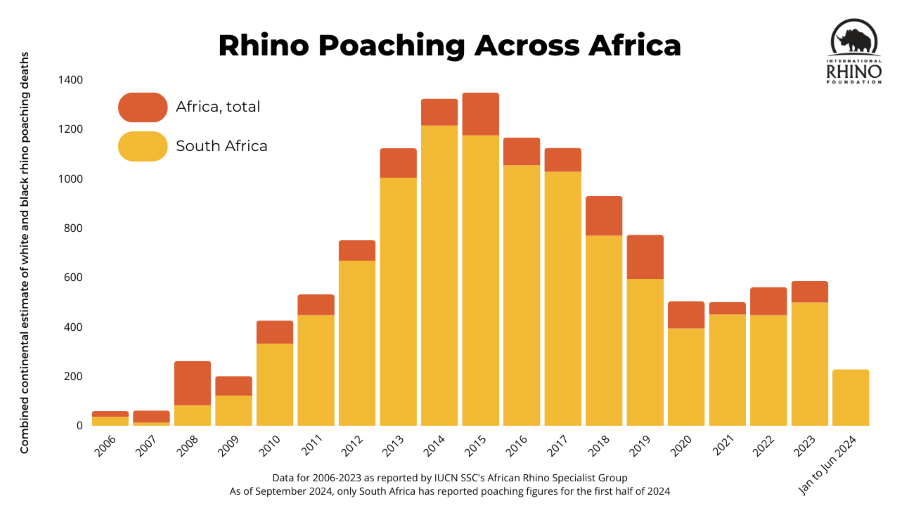One Rhinoceros gets killed in Africa after every 15 hours and according to a new State of the Rhino Report of 2024, more than 586 African rhinos were poached in the course of 2023.
The State of the Rhino Report 2024 indicates that Rhino poaching in Africa increased by 4 percent from 2022 to 2023.
While thriving in several regions, the total black rhino population declined slightly over the last year due to heavy poaching in Namibia and Hluhluwe iMfolozi Park in South Africa.
However White rhino populations in South Africa are on the rise despite poaching.
Greater one-horned rhinos, according to the report, have been making use of improved habitats and wildlife corridors.
Every September, the International Rhino Foundation (IRF) publishes their signature report, State of the Rhino, which documents current population estimates and trends, where available, as well as key challenges and conservation developments for the five surviving rhino species in Africa and Asia.
The Tanzania Times is publishing here an extract from the report.
Many rhino range states don’t conduct rhino counts every year so are unable to provide annual population estimates – and even when they do they don’t always publish the data.
Countries that are part of the Convention on International Trade in Endangered Species of Wild Fauna and Flora (CITES), the international agreement between governments created to ensure that wildlife trade doesn’t impact species’ survival, generally report population counts every two to three years in conjunction with the CITES Conference of the Parties.
While understanding rhino population numbers is considered by most to be essential, collecting and sharing data can be prohibitive or problematic.
The threat of poaching adds a layer of complexity to releasing information about rhino populations.
Publishing data on the size or locations of populations for a taxon like rhinos that are highly sought after for the illegal wildlife trade could assist criminal syndicates in identifying target areas to poach.
Some Governments may also avoid releasing population data to downplay news on any increasing populations.
On the other hand, some governments may want to avoid the embarrassment of sharing news of decreasing population numbers.

And publishing raw population data without proper context can be misleading.
For example, an increase in numbers might suggest rhinos are thriving when significant threats are still present, giving people a false sense of security or complacency.
Logistically, rhino populations in many areas are extremely difficult to count.
Rhinos are often solitary and can be difficult to spot, especially in dense vegetation.
Their shy behavior makes it hard to track them consistently, leading to underestimation in population counts.
Whether they are roaming over vast landscapes like Kruger National Park in South Africa or quietly traversing through dense jungles such as Ujung Kulon National Park in Indonesia, surveying these areas is difficult and expensive.
It requires significant resources such as aerial surveillance, camera traps and tracking teams.
Additionally, animals can disperse over borders between countries, risking either double counting or individuals being missed entirely.
Governmental wildlife agencies may not have sufficient resources to invest in frequent and comprehensive population assessments.
Black Rhino
IUCN Estimated Population and Status: 6,421; Critically Endangered
Black rhinos (Diceros bicornis) can currently be found in 12 countries in Africa, totaling an estimated 6,421 individuals.
The black rhino population is made up of three subspecies, including approximately 2,583 south-western (D.b. bicornis); 2,450 southern (D.b. minor) and 1,388 eastern (D.b. michaeli). A fourth subspecies, the western black rhino (D.b. longipes), was declared extinct in 2011; its last evidence of existence was in Cameroon in 2006.
At one time, black rhinos were the most common of the world’s rhino species and records indicate there could have been as many as 100,000 throughout Africa in 1960.
By 1970, poaching had reduced the population to approximately 65,000 and black rhinos continued to decline precipitously until a low of about 2,300 individuals in the mid-1990s.
Thanks to intense protection and management efforts, black rhino populations stabilized and, despite ongoing poaching pressure, have increased by approximately 28 percent over the last decade.
The African Rhino Specialist Group (AfRSG) recently reported that the total black rhino population as of the end of 2023 is now approximately 6,421 – a 1 percent decrease over the last year, due mostly to the concentrated poaching seen in Namibia and South Africa’s Hluhluwe iMfolozi Park.
This slight decrease is the first noted for black rhinos since 1995, and hopefully only a one-time pause in their otherwise steady growth.
White Rhino
IUCN Estimated Population and Status: 17,464; Near Threatened
White rhinos (Ceratotherium simum) are the most populous of the five rhino species with approximately 17,464 animals across 11 countries in Africa.
There are two white rhino subspecies, southern (C.s. simum) and northern (C.s. cottoni), but as there are only two northern white rhinos left in the world – both females – that subspecies is considered functionally extinct.
Historically as a species, white rhinos made an incredible comeback from fewer than 100 individuals in the early 1900s to more than 21,000 at the end of 2012.
Unfortunately, from 2012 to 2021, their large numbers made them the primary target for rhino poachers, who are part of transnational criminal syndicates looking to sell rhino horn on the black market.
During this period, white rhino numbers decreased by 24 percent to an estimated 15,942.
Although the number of rhino deaths annually has decreased since the most recent peak in 2015, poaching remains the biggest threat to rhinos, and white rhinos in particular bear the brunt.
In 2023 the International Union for the Conservation of Nature (IUCN) Species Survival Commission’s African Rhino Specialist Group (AfRSG) announced the first population increase for the white rhino species in over a decade.
They have recently announced another 3.4 percent increase for white rhinos, bringing their species estimate to 17,464 as of the end of 2023.
No Standard for Census on Rhino
There is no single standard for counting rhinos.
Different countries use various techniques tailored to their species and unique habitat.
In India and Nepal rhinos are counted every 3-4 years by large teams of people riding elephants in order to spot rhinos while staying safe from rhinos and other wildlife.
In some countries camera traps are used to identify and estimate rhino populations.
And in others helicopters and aerial teams are used to count rhinos over vast landscapes. In Namibia rhino rangers track rhinos by vehicle and record every single rhino using an ear notching identification method.
No method for counting rhinos is 100 percent accurate every time, but scientists make their estimates with the best available data.
Rhino conservation is nuanced and challenging, even with accurate population assessments.
But when this most basic of conservation needs goes unfulfilled, it hinders rhino protection and preservation around the globe.
The aim of the International Rhino Foundation’s (IRF) annual State of the Rhino report is to not only provide accurate numbers and trends, but to also share the context in which they occur to support rhino conservation efforts in Africa and Asia.
The 2024 report shows population estimates for black and white rhinos as of the end of 2023, while individual rhino range country data may only be as recent as of the end of 2021.
For countries where there are conflicting numbers, either through different census methods or from different sources, we have provided that information as well.
And for all five species, we have included our thoughts on population trends – where we are most concerned and where we’re celebrating successes.
All of this is in service to the collective work IRF conducts with partners around the globe, helping ensure all five rhino species survive.
How Many Rhinos are in each country of Africa? Find out Here

